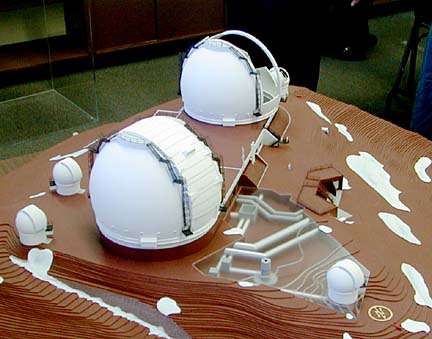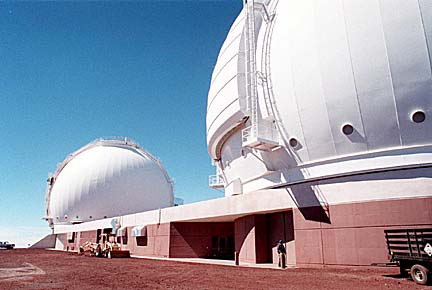Advertisement - Click to support our sponsors.


What else HILO -- Are we alone in the universe? The National Aeronautics and Space Administration wants to know.
is out there?
Isle scopes may find out
NASA wants to build four
'outrigger' telescopes around the
twin Kecks for a search
outside our solar systemBy Rod Thompson
Star-BulletinTo answer the question, the agency will spend the next 10 to 20 years looking for planets outside our solar system that could be a home for living things, NASA official Richard Howard told the University of Hawaii Mauna Kea Management Board yesterday.
A key part of the search is the proposed placement of four to six small "outrigger" telescopes around the huge twin Keck telescopes on Mauna Kea, Howard said.
The outriggers must be approved by the state Department of Land and Natural Resources and by the University of Hawaii, which have joint control of Mauna Kea. The new advisory management board will make a recommendation to the university president.

NASA has $45 million to fund four outriggers, Howard said. It is planning for two additional ones, but the earliest they would be built -- if at all -- would be after 2006, he said.The California Association for Research in Astronomy, which runs the Keck telescopes, would also operate the outriggers.
Keck already has a $23 million project under way to link the light from its two telescopes, each with a main mirror 10 meters or 33 feet across.
Underground pipes would carry light linking the outriggers to each other and to Keck. The mirrors of the outriggers would be 1.8 meters -- about 6 feet -- across.
The height of the outrigger domes would be about a third as high as the Keck domes.
The outriggers would be built on land already bulldozed for the Kecks, including the Keck parking lot.
The domes must be white or silver, said Keck head Fred Chaffee. Any other color makes them too hot and ruins their observing ability, he said.
An archaeologist and probably a "cultural monitor" would oversee construction, said NASA official Kenneth Kumor.
There is no other site in the northern hemisphere as good as Mauna Kea for the outriggers, Chaffee said.
Keck plans to increase its staff 20 percent for the outriggers, Chaffee said. "To lose the outriggers would be detrimental to astronomy in Hawaii.
"It would send a very clear message that astronomy is not welcome here," he said.
The outriggers would look for the "wobble" of nearby stars that would indicate the gravity of large planets tugging on them.
Astronomers would look for "hot Jupiters," planets the size of Jupiter in our solar system but radiating more heat.
They would also look for dust around around other stars, and empty places amidst the dust showing that planets are sweeping it up.
They have no idea what they'll find. "We don't have a clue whether our solar system is typical," Howard said.
Chaffee added a spiritual question: "What did God put into the universe for us to look at?"